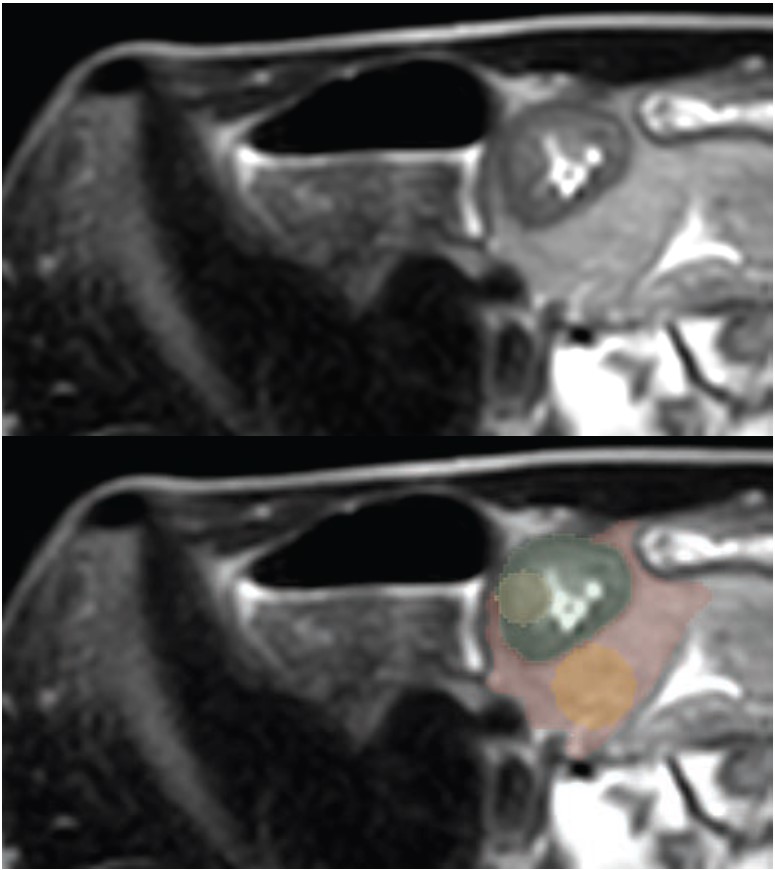Consortium Advances Crohn Disease Intestinal Strictures Imaging
Images

Researchers from the Stenosis Therapy and Anti-Fibrotic Research (STAR) consortium have developed reliable methods to measure intestinal strictures using both MRI and CT imaging. This advancement, published in Radiology, marks a significant step toward effective medical therapies for Crohn disease-related intestinal strictures.
Crohn disease can cause narrowing of the bowel, known as intestinal strictures, due to the buildup of scar tissue (called fibrosis), muscular thickening, and inflammation. It is a common complication often leading to bowel obstructions, resulting in surgery and bowel resections in patients.
There are no medical therapies for Crohn intestinal strictures largely because of the lack of objective tools that allow for clinical testing of antifibrotic drugs.
The STAR consortium, composed of researchers from Alimentiv Inc., Cleveland Clinic, and Mayo Clinic, and supported by The Leona M. and Harry B. Helmsley Charitable Trust, has published results addressing this unmet medical need by demonstrating the reliable measurement and description of intestinal strictures. Their approach uses both MRI and CT imaging of the bowel to deliver consistent results across patients and interpreting radiologists.
This breakthrough paves the way for the development of antifibrotic therapies in stricturing Crohn disease by providing reliable measurable radiological outcomes for clinical trials. Researchers can now use these imaging techniques to determine patient eligibility for clinical trials and assess the effectiveness of antifibrotic therapies. These methods can also be used by radiologists, gastroenterologists and surgeons in daily clinical practice. These results have been shared with research partners, and a clinical trial evaluating the first medical therapy is underway.
The STAR consortium is dedicated to transforming the treatment of Crohn disease strictures with their research, extending beyond developing imaging-based methods. They are also seeking to understand the genetic and molecular mechanisms that contribute to the development and progression of strictures. Additionally, they are working to validate a patient-reported outcome tool that measures symptoms and whether their experiences may be indicative of a therapy's success or failure.
The STAR consortium consolidates and shares knowledge of Crohn disease strictures with leading academic research institutions across the globe, and pharmaceutical and biotechnology partner organizations.
"At Helmsley, we are committed to supporting research that builds standards and biomarkers for Crohn disease, which are crucial to the development of new therapies," said Laurie Churchill, Program Officer at the Helmsley Charitable Trust. "These new findings from the STAR Consortium bring us closer to developing treatments for intestinal strictures — we are proud to continue to support this important work."
"Our research findings provide much-needed tools for the medical community to allow testing of antistricture therapies in our Crohn disease patients. Treating strictures is one of the largest unmet needs in the field of inflammatory bowel diseases. This work, performed by an international, multi-institutional and multidisciplinary expert team paves the way to novel therapy approaches," says Florian Rieder MD, who is Vice Department Chair and Director of Global Translational IBD at the Cleveland Clinic.
"We are hopeful that for patients with stricturing Crohn disease and their families, these developments, which have arisen from interdisciplinary collaboration of experts across the world, will speed the development of antifibrotic drugs that will reduce intestinal obstructions, morbidity and surgeries, and that these findings can be used to improve the daily care of Crohn disease patients," says J. G. Fletcher, MD, a Mayo Clinic radiologist.
"These findings bring renewed hope that we are entering a new age of great progress for the management of fibrostenosing Crohn disease,"
says David Bruining, MD, who is part of the Mayo Clinic Inflammatory Bowel Disease Clinic.
"This research is a milestone in our ability to fight Crohn disease with imaging technology. For the first time, we have a reliable way to measure and track intestinal strictures, opening the door to targeted therapies that could drastically improve patient outcomes. We are excited about the potential of this research to transform the lives of those suffering from this debilitating condition," says Brian G. Feagan, MD, who is the senior scientific director at Alimentiv.